To add a reference to the Web Service, right-click the project name in Solution Explorer and select Add Service Reference (see Figure 20-3).
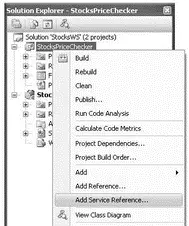
Figure 20-3
In the Add Service Reference dialog, enter the URL for the Web Service that you created earlier (see Figure 20-4). Because the Web Service is in the current solution, you can also click the Discover button to locate the Web Service.
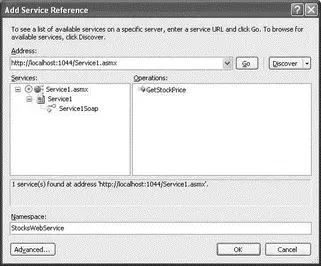
Figure 20-4
In Visual Studio 2008, the Add Service Reference option replaces the Add Web Reference option. That's because WCF is the preferred way to write your services in Visual Studio 2008. The exception to this is when developing Windows Mobile applications — for those, the Add Web Reference option is available, but the Add Service Reference item is not.
Give a name to the Web Service (say, StocksWebService), and click OK. A reference to the Web Service is added to the project (see Figure 20-5).
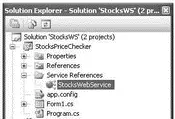
Figure 20-5
The StocksWebServiceis a proxy class generated by Visual Studio 2008 to handle all the work of mapping parameters to XML elements and then sending the SOAP messages over the network to the Web Service. Behind the scenes, Visual Studio has actually downloaded the WSDL (Web Services Description Language) document from the Web Service so that it knows exactly what the service offers and requires. You can view the WSDL document of the document by appending ?WSDLto the end of the Web Services URL, like this:
http://localhost:1044/Service1.asmx?WSDL
To access the services provided by the Web Service, you programmatically create an instance of the proxy class and then call the appropriate methods. Here's the code for the Check Price button:
private void btnCheckPrice_Click(object sender, EventArgs e) {
StocksWebService.Service1SoapClient ws =
new StocksPriceChecker.StocksWebService.Service1SoapClient();
MessageBox.Show("Price for " + txtSymbol.Text + " is " +
ws.GetStockPrice(txtSymbol.Text));
}
Set the StocksPriceCheckerproject as the startup project in Visual Studio 2008, and press F5 to debug the application. When you enter a stock symbol and click Check Price, the Web Service returns the price of the specified stock (see Figure 20-6).
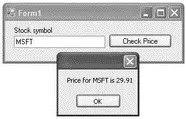
Figure 20-6
From this very simple example, you want to note the following:
□ You need to host even a simple ASMX Web Service on a web server such as IIS.
□ To access the Web Service, clients use HTTP, a stateless protocol, which means that every request is treated like a new one. If you want to write an application that requires the Web Service to remember its previous state, you need to implement your own "stateful" mechanism.
□ The ASMX Web Service uses a request/response communication model. The Web Service only responds when requested by the client. In this example, if you need to monitor the price of a stock and want to be notified whenever a stock falls below a certain price, you must constantly poll the Web Service to retrieve the latest price. A better way would be to have a service that can automatically invoke the client when specific events happen on the service's end. You'll see how this can be done with WCF later in this chapter.
Comparing WCF with ASMX Web Services
Now that you've created a traditional ASMX Web Service, let's compare ASMX and WCF and see how they differ:
□ ASMX Web Services use web methods that are exposed to the world. Web methods use the request/response communication models. In WCF, these web methods are known as operations , and you can use any one of the three different types of communication models: one-way transaction, request/response, and full-duplex.
□ Web services use the Simple Object Access Protocol (SOAP) messaging transported over HTTP. WCF can utilize different protocols for messaging — SOAP, Plain Old XML (POX), and so on — transported over a wide variety of communication protocols, including TCP and HTTP.
□ Web services listen at a particular port number (such as port 80); WCF can have multiple endpoints listening at different port numbers.
□ Web services are hosted by web servers (such as IIS); WCF can be hosted in different forms, such as Windows services, Windows applications, or just processes.
Developing a WCF service using Visual Studio 2008 will be helpful in comparing it with the traditional ASMX Web Services.
Using Visual Studio 2008, create a new WCF Service Library application, and name it WcfServiceLibraryTest(see Figure 20-7).
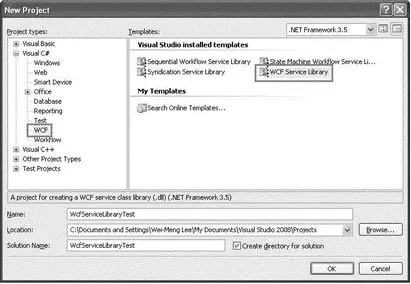
Figure 20-7
Notice the two files created in the project (see Figure 20-8):
□ iService1.cscontains the service contract as well as the data contract.
□ Service1.cscontains the implementation of the contract defined in the IService1.csfile.

Figure 20-8
Here's the content of the IService1.csfile:
using System;
using System.Collections.Generic;
using System.Linq;
using System.Runtime.Serialization;
using System.ServiceModel;
using System.Text;
namespace WcfServiceLibraryTest {
// NOTE: If you change the interface name "IService1" here, you must also
// update the reference to "IService1" in App.config.
[ServiceContract]
public interface IService1 {
[OperationContract]
string GetData(int value);
[OperationContract]
CompositeType GetDataUsingDataContract(CompositeType composite);
// TODO: Add your service operations here
}
// Use a data contract as illustrated in the sample below to add composite
// types to service operations
[DataContract]
public class CompositeType {
bool boolValue = true;
string stringValue = "Hello ";
[DataMember]
public bool BoolValue {
get { return boolValue; }
set { boolValue = value; }
}
[DataMember]
public string StringValue {
get { return stringValue; }
set { stringValue = value; }
}
}
}
Here, there is an interface ( IService1) and a class ( CompositeType) defined. The IService1interface is set with the [ServiceContract]attribute to indicate that this is a service contract and contains signatures of operations exposed by the service. Within this interface are signatures of methods that you will implement in the Service1.csfile. Each method is set with the [OperationContract]attribute to indicate that it is an operation. If you have additional operations to add, you can add them here.
Читать дальше


















